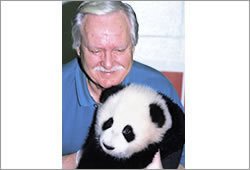YuYu interview Donald G Lindburg
 |
| —— People from everywhere and all walks of life love the pandas, what is it about them that touch people? Well, pandas are very charismatic...they excite people like few other mammals do! They remind us of children or toddlers, because of their rather clumsy manner and their playfulness. You could just imagine a child doing the exact things they do...they fall off a log, then get up and try to climb right back on it. Their physical appearance is also important, it's not just distinctive, but their large round head and big ears...these have been shown to be "releasers" in the study of animal behavior...meaning there is a sort of inbuilt response which tends to elicit emotional responses in just about everyone. When Hua-Mei was quite small and playful, we hosted many visitors. One doctor in particular was a bit "detached"...he'd never shown much of a personal interest before...but after spending some time with Hua-Mei, he looked at me with his big watering eyes and admitted "I never thought the impact would be so powerful". I think a lot of people feel that way! —— The pandas have become almost synonymous with the San Diego Zoo, how did we come to host these fascinating animals? I believe it's been since the 1950's and maybe before that the Board at the Zoo has had an interest in bringing pandas to San Diego, but it wasn't until 1979 that we actually sent a delegation to China. By the late eighties we had a letter of intent for the export of 2 giant pandas, but it wasn't until Sept. 10, 1996 that Bai-Yun and Shi-Shi finally arrived here. You see, our government had established a moratorium against further importations because of the commercial exploitation that had been taking place. Zoos were hosting pandas for pure commercial gain and our government wanted to put a halt to it. As a result, importation become very difficult and our original application for captive breeding was denied. —— So what happened next?  Eventually we prepared a new proposal, this time for the purpose of studying the communication system of giant pandas. That was just about the time I became involved. I had convinced our director that as a behavioral specialist, I should go to China to observe the pandas current behavior and environment, so that we could compare and contrast them at a later date. I felt it was my obligation because communication is about behavior and I was the head of the behavior division. I had no idea how emotionally involved I would become or how extremely rewarding working with the pandas would be. In our proposal we attempted to demonstrate how our work here and our related work in China would benefit the wild population. We were in limbo for a while, but since we already had an agreement with the Chinese government, we were allowed to proceed. Finally, in 1994 we were issued an import permit. Subsequently, our proposal became the model for US policy and for all others to follow. We wrote the policy without ever intending to do so! Eventually we prepared a new proposal, this time for the purpose of studying the communication system of giant pandas. That was just about the time I became involved. I had convinced our director that as a behavioral specialist, I should go to China to observe the pandas current behavior and environment, so that we could compare and contrast them at a later date. I felt it was my obligation because communication is about behavior and I was the head of the behavior division. I had no idea how emotionally involved I would become or how extremely rewarding working with the pandas would be. In our proposal we attempted to demonstrate how our work here and our related work in China would benefit the wild population. We were in limbo for a while, but since we already had an agreement with the Chinese government, we were allowed to proceed. Finally, in 1994 we were issued an import permit. Subsequently, our proposal became the model for US policy and for all others to follow. We wrote the policy without ever intending to do so!—— Were there a lot of preparations that had to be made for our new residents? Interestingly enough, the Zoo had already built an exhibit to accommodate up to eight pandas at the time we applied for our original permit. So it had been sitting there empty for about 4 years, while we were waiting for all of the paperwork and approvals to be processed. —— Can you tell us a little bit about our giant pandas? Well, as part of our loan we received two giant pandas from the Wolong Center in China; the male Shi-Shi and female Bai-Yun. At one time Shi-Shi was a wild pandas who had been severely wounded and near death...he was a bona-fide rescue and had been living in captivity for several years prior to coming here. Bai-Yun our female, on the other hand, was a captive born pandas...in fact, the very first captive born female to be born at the Wolong Center. So they gave up quite a bit in sending her here. And of course there is Hua-Mei... born right here at the SD Zoo, who in addition to being loved by millions, is the first giant panda born in North America to survive past four days in the last decade. Personality wise, Shi-Shi is very very old and much less active, while Bai-Yun and Hua-Mei are much more lively, outgoing and friendly animals that respond to and recognize things much more readily. For example, a few years ago we had a keeper who would run around the perimeter of the large enclosure...when Bai-Yun saw this she would follow her and run along the inside (laughing). That was pretty interesting! —— So how do pandas communicate with one another? Since pandas are solitary animals we knew that their sense of smell was very important. Pandas have a specialized gland that they rub on structures in their environment and that's how they leave a message for other pandas that come along over the next weeks or months. Shi-Shi is a retiring low-level responder, in other words he rarely scent-marked. From the very start, he was uninterested in the female even when she was trying very hard to get his attention. In contrast, Bai-Yun is more outgoing and interacts much more frequently. Also, males and females use their scent in different ways...for the males it's an identification of their living area, while for females it's more of an indicator of their reaching sexual receptivity. Placement also evokes different responses...males for example will elevate their hind-end up the trunk of the tree while standing on their hands...it seems the females prefer the higher marks so the question is why? We think that the higher the mark the bigger the male...and therefore the more desirable he is as a mate. Even Hua-Mei was trying to scent-mark, long before she had a scent gland. She was kind of awkward, but she thought...mom is doing it I may as well do it too! —— Do they growl or make other types of sounds to communicate?  Generally speaking, pandas are pretty quiet most of the time. We think we can draw a distinction between distance communicators and close-range communicators. Communicating via scent is like putting up a notice on the community bulletin board. But in close range, such as during mating, sounds assume a lot more importance. Pandas have a range of sounds they use ... from aggressive "barks", to friendly "bleats", which are goat-like sounds, in addition to what we call "honking" which shows a mild level of distress. When they're happy they "bleat" and sometimes in close-range they may even make an aggressive clacking sound with their teeth and jaws. Generally speaking, pandas are pretty quiet most of the time. We think we can draw a distinction between distance communicators and close-range communicators. Communicating via scent is like putting up a notice on the community bulletin board. But in close range, such as during mating, sounds assume a lot more importance. Pandas have a range of sounds they use ... from aggressive "barks", to friendly "bleats", which are goat-like sounds, in addition to what we call "honking" which shows a mild level of distress. When they're happy they "bleat" and sometimes in close-range they may even make an aggressive clacking sound with their teeth and jaws.—— What about their physical behavior...when they're happy for instance? They love to roll around. In China, I've seen groups of yearlings together and they're just like a little group of playful kids...one will push another one over and it tumbles back and then they jump up and start gnawing on each other's ears. —— The birth of Hua-Mei created such a sensation, what have we learned from our little celebrity's birth? She’s not so little anymore! When she was born, Hua-Mei weighed only a quarter of a pound and her mother was in the order of 800 times larger, which is the greatest discrepancy in all placental mammals. Now she's bigger than her mother and weighs over 200 lbs. One of the more interesting things was the incredible helplessness of the infant with the flip-side being the incredible devotion of Bai-Yun to keep her alive. For example, she didn't leave Hua-Mei for 5 days...for anything! She gave her constant attention and finally, after 9 days she came out for a little bite to eat. In Hua-Mei's case, we observed that her fore-limbs developed before her hind limbs did. Now, we think this is true of all pandas, but at first some of us thought something might be wrong. She could sit up ... like a tripod and scoot on her rear end before she could stand up on all fours. —— Can you describe what it's like to hold Hua-Mei? When she was very young her coat was soft like a puppy’s, but now that she has grown and her coat has become a bit stiffer and oilier, which helps to prevent water penetration. The picture you see of me holding her was taken when she was just a few months old during one of her weigh-ins. —— Everyone is sad that Hua-Mei will be leaving SD, when will that happen and what other changes can we expect? As part of our agreement with China, Hua-Mei will be sent to Wolong, where her parents came from. Since it's so cold in China now, it probably won't be until spring and she'll be a part of their captive breeding program. Next month, however, Shi-Shi will be returning to China and we'll be receiving a younger male. We’re excited because this will give us better opportunities to observe a younger more active male...and he likes the ladies! Long-term we have 6 more years to go on our 12 year agreement. And it'll be hard to say what the status of Pandas in the world will be at that time... We'll be sorry to say goodbye to Hua-Mei, but very thankful to have known her. I don't know how many people have told us they had a bad day at work but when they saw Hua-Mei or turned on the Panda-Cam they had their spirits lifted! It's absolutely astonishing the impact they have on us...that's why it's so much fun to be here and be involved with them! (11-16-2002 issue, Interviewed by Terry Nicholas) |

